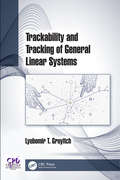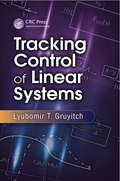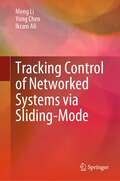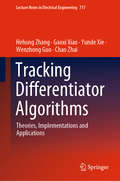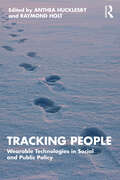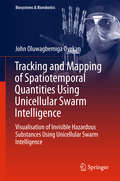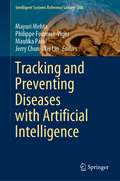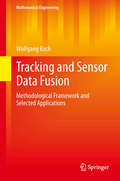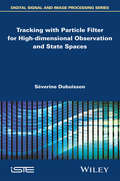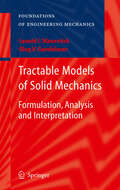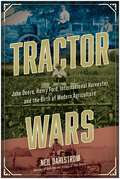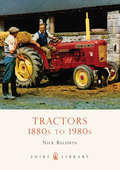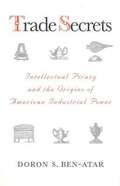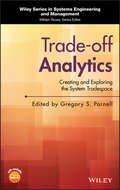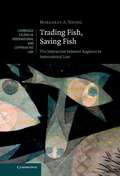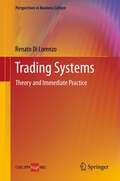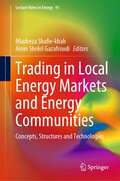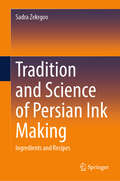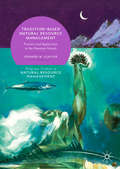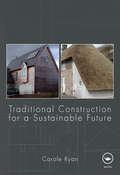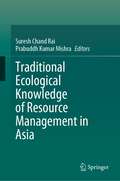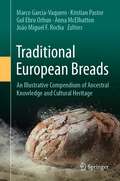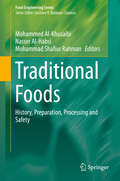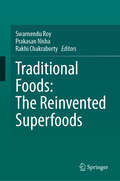- Table View
- List View
Trackability and Tracking of General Linear Systems
by Lyubomir GruyitchTrackability and Tracking of General Linear Systems deals with five classes of the systems, three of which are new, begins with the definition of time together with a brief description of its crucial properties and with the principles of the physical uniqueness and continuity of physical variables. They are essential for the natural tracking control synthesis. The book presents further new results on the new compact, simple and elegant calculus that enabled the generalization of the transfer function matrix concept and of the state concept, the completion of the trackability and tracking concepts together with the proofs of the trackability and tracking criteria, as well as the natural tracking control synthesis for all five classes of the systems. Features • Crucially broadens the state space concept and the complex domain fundamentals of the dynamical systems to the control systems. • Addresses the knowledge and ability necessary to study and design control systems that will satisfy the fundamental control goal. • Outlines new effective mathematical means for effective complete analysis and synthesis of the control systems. • Upgrades, completes and essentially generalizes the control theory beyond the existing boundaries. • Provides information necessary to create and teach advanced inherently upgraded control courses.
Tracking Control of Linear Systems
by Lyubomir T. GruyitchThe primary purpose of control is to force desired behavior in an unpredictable environment, under the actions of unknown, possibly unmeasurable disturbances and unpredictable, and therefore probably nonzero, initial conditions. This means that tracking and tracking control synthesis are fundamental control issues. Surprisingly, however, tracking theory has not been well developed, and stability theory has dominated. Tracking Control of Linear Systems presents the fundamentals of tracking theory for control systems. The book introduces the full transfer function matrix F(s), which substantially changes the theory of linear dynamical and control systems and enables a novel synthesis of tracking control that works more effectively in real environments.An Introduction to the New Fundamentals of the Theory of Linear Control SystemsThe book begins by re-examining classic linear control systems theory. It then defines and determines the system full (complete) transfer function matrix F(s) for two classes of systems: input-output (IO) control systems and input-state-output (ISO) control systems. The book also discusses the fundamentals of tracking and trackability. It presents new Lyapunov tracking control algorithms and natural tracking control (NTC) algorithms, which ensure the quality of the tracking under arbitrary disturbances and initial conditions. This natural tracking control is robust, adaptable, and simple to implement.Advances in Linear Control Systems Theory: Tracking and TrackabilityThis book familiarizes readers with novel, sophisticated approaches and methods for tracking control design in real conditions. Contributing to the advancement of linear control systems theory, this work opens new directions for research in time-invariant continuous-time linear control systems. It builds on previous works in the field, extending treatment o
Tracking Control of Networked Systems via Sliding-Mode
by Yong Chen Meng Li Ikram AliThe book focuses on the research methods of networked control systems via sliding mode. The problems with network disturbances, network induced delay, out-of-sequence and packet loss, and network attacks are studied in detail. The content studied in this book is introduced in detail and is verified by simulation or experiment. It is especially suitable for readers who are interested in learning the control scheme of networked systems. This book can benefit researchers, engineers, and students in related fields such as electrical, control, automation, and cyber security.
Tracking Differentiator Algorithms: Theories, Implementations and Applications (Lecture Notes in Electrical Engineering #717)
by Gaoxi Xiao Hehong Zhang Yunde Xie Wenzhong Guo Chao ZhaiThis book highlights designs, implementations and applications of tracking differentiator (TD) algorithms. The real-time differentiation estimation of a given signal is of high importance in control science and engineering. A good differentiator shall have i) robustness against input noises and ii) exactness with a small phase delay. The book has three focuses:Designing practical, accurate and efficient TD based on discrete-time optimal control (DTOC).Presenting full convergence analysis on DTOC-TDs.Implementing the DTOC-TDs in state estimations in power systems and signal processing, as well as feedback control in maglev train.The proposed TD solution and its successful real-life applications shall stimulate wide interests in different areas including power systems, railway transportations and aerospace industry, etc.
Tracking People: Wearable Technologies in Social and Public Policy
by Raymond HoltTracking technologies are now ubiquitous and are part of many people’s everyday lives. Large sections of the population voluntarily use devices and apps to track fitness, medical conditions, sleep, vital signs or their own or others’ whereabouts. Governments, health services, immigration and criminal justice agencies increasingly rely upon tracking technologies to monitor individuals’ whereabouts, behaviour, medical conditions and interventions. Despite the human rights concerns of some organisations and individuals, most wearers and their significant others tend to welcome the technologies. This paradox is only one of the many fascinating challenges raised by the widespread use of tracking technologies which are explored in this book. This book critically explores the ethical, legal, social, and technical issues arising from the current and future use of tracking technologies. It provides a unique and wide-ranging discussion, via a cross-disciplinary collection of essays, on issues relating to technological devices and apps whose use is imposed upon wearers or suggested by others, whether agencies or individuals, including in the domains of criminal justice, terrorism, and health and social care. Contributions from leading academics from across social sciences, engineering, computer and data science, philosophy, and health and social care address the diverse uses of tracking technologies including with individuals with dementia, defendants and offenders, individuals with mental health conditions and drug users alongside legal, ethical and normative questions about the appropriate use of these technologies. Cross-disciplinary themes emerge focusing on both the benefits of the technologies – freedom, improved safety, security, well-being and autonomy, and increased capacity of and efficiencies for public services – and the challenges – implementation and operational costs, mission creep, privacy concerns, stigmatisation, whether the technologies work as expected, and useability and wearability for all wearers. This book is essential reading for academics and students engaged in criminology, criminal justice, socio-legal studies, science and technology studies, medicine, health and social care, psychology, engineering, computer and data science, philosophy, social policy and social work and security studies. It will also be of great interest to policy-makers, regulators, practitioners already deploying or considering using tracking technologies, and to current and potential wearers.
Tracking and Mapping of Spatiotemporal Quantities Using Unicellular Swarm Intelligence
by John Oluwagbemiga OyekanThe book discusses new algorithms capable ofsearching for, tracking, mapping and providing a visualization of invisiblesubstances. It reports on the realization of a bacterium-inspired roboticcontroller that can be used by an agent to search for any environmental spatialfunction such as temperature or pollution. Using the parameters of amathematical model, the book shows that it is possible to control theexploration, exploitation and sensitivity of the agent. This feature sets thework apart from the usual method of applying the bacterium behavior to roboticagents. The book also discusses how a computationally tractable multi-agentrobotic controller was developed and used to track as well as provide a visualmap of a spatio-temporal distribution of a substance. On the one hand, thisbook provides biologists and ecologists with a basis to perform simulationsrelated to how individual organisms respond to spatio-temporal factors in theirenvironment as well as predict and analyze the behavior of organisms at apopulation level. On the other hand, it offers robotic engineers practical andfresh insights into the development of computationally tractable algorithms forspatial exploratory and mapping robots. It also allows a more general audienceto gain an understanding of the design of computational intelligence algorithmsfor autonomous physical systems.
Tracking and Preventing Diseases with Artificial Intelligence (Intelligent Systems Reference Library #206)
by Jerry Chun-Wei Lin Philippe Fournier-Viger Mayuri Mehta Maulika PatelThis book presents an overview of how machine learning and data mining techniques are used for tracking and preventing diseases. It covers several aspects such as stress level identification of a person from his/her speech, automatic diagnosis of disease from X-ray images, intelligent diagnosis of Glaucoma from clinical eye examination data, prediction of protein-coding genes from big genome data, disease detection through microscopic analysis of blood cells, information retrieval from electronic medical record using named entity recognition approaches, and prediction of drug-target interactions.The book is suitable for computer scientists having a bachelor degree in computer science. The book is an ideal resource as a reference book for teaching a graduate course on AI for Medicine or AI for Health care. Researchers working in the multidisciplinary areas use this book to discover the current developments. Besides its use in academia, this book provides enough details about the state-of-the-art algorithms addressing various biomedical domains, so that it could be used by industry practitioners who want to implement AI techniques to analyze the diseases. Medical institutions use this book as reference material and give tutorials to medical experts on how the advanced AI and ML techniques contribute to the diagnosis and prediction of the diseases.
Tracking and Sensor Data Fusion
by Wolfgang KochSensor Data Fusion is the process of combining incomplete and imperfect pieces of mutually complementary sensor information in such a way that a better understanding of an underlying real-world phenomenon is achieved. Typically, this insight is either unobtainable otherwise or a fusion result exceeds what can be produced from a single sensor output in accuracy, reliability, or cost. This book provides an introduction Sensor Data Fusion, as an information technology as well as a branch of engineering science and informatics. Part I presents a coherent methodological framework, thus providing the prerequisites for discussing selected applications in Part II of the book. The presentation mirrors the author's views on the subject and emphasizes his own contributions to the development of particular aspects. With some delay, Sensor Data Fusion is likely to develop along lines similar to the evolution of another modern key technology whose origin is in the military domain, the Internet. It is the author's firm conviction that until now, scientists and engineers have only scratched the surface of the vast range of opportunities for research, engineering, and product development that still waits to be explored: the Internet of the Sensors.
Tracking with Particle Filter for High-dimensional Observation and State Spaces
by Séverine DubuissonThis title concerns the use of a particle filter framework to track objects defined in high-dimensional state-spaces using high-dimensional observation spaces. Current tracking applications require us to consider complex models for objects (articulated objects, multiple objects, multiple fragments, etc.) as well as multiple kinds of information (multiple cameras, multiple modalities, etc.). This book presents some recent research that considers the main bottleneck of particle filtering frameworks (high dimensional state spaces) for tracking in such difficult conditions.
Tractable Models of Solid Mechanics
by Oleg V. Gendelman Leonid I. ManevitchThis book describes significant tractable models used in solid mechanics - classical models used in modern mechanics as well as new ones. The models are selected to illustrate the main ideas which allow scientists to describe complicated effects in a simple manner and to clarify basic notations of solid mechanics. A model is considered to be tractable if it is based on clear physical assumptions which allow the selection of significant effects and relatively simple mathematical formulations. The first part of the book briefly reviews classical tractable models for a simple description of complex effects developed from the 18th to the 20th century and widely used in modern mechanics. The second part describes systematically the new tractable models used today for the treatment of increasingly complex mechanical objects - from systems with two degrees of freedom to three-dimensional continuous objects.
Tractor Wars: John Deere, Henry Ford, International Harvester, and the Birth of Modern Agriculture
by Neil Dahlstrom"Mr. Dahlstrom...has written a superb history of the tractor and this long-forgotten period of capitalism in U.S. agriculture. We now know the whole story of when farming, business and the free-market economy diverged, divided and conquered." —Wall Street Journal Discover the untold story of the &“tractor wars,&” the twenty-year period that introduced power farming—the most fundamental change in world agriculture in hundreds of years. Before John Deere, Ford, and International Harvester became icons of American business, they were competitors in a forgotten battle for the farm. From 1908-1928, against the backdrop of a world war and economic depression, these brands were engaged in a race to introduce the tractor and revolutionize farming. By the turn of the twentieth century, four million people had left rural America and moved to cities, leaving the nation&’s farms shorthanded for the work of plowing, planting, cultivating, harvesting, and threshing. That&’s why the introduction of the tractor is an innovation story as essential as man&’s landing on the moon or the advent of the internet—after all, with the tractor, a shrinking farm population could still feed a growing world. But getting the tractor from the boardroom to the drafting table, then from factory and the farm, was a technological and competitive battle that until now, has never been fully told. A researcher, historian, and writer, Neil Dahlstrom has spent decades in the corporate archives at John Deere. In Tractor Wars, Dahlstrom offers an insider&’s view of a story that entwines a myriad of brands and characters, stakes and plots: the Reverend Daniel Hartsough, a pastor turned tractor designer; Alexander Legge, the eventual president of International Harvester, a former cowboy who took on Henry Ford; William Butterworth and the oft-at-odds leadership team at John Deere that partnered with the enigmatic Ford but planned for his ultimate failure. With all the bitterness and drama of the race between Ford, Dodge, and General Motors, Tractor Wars is the untold story of industry stalwarts and disruptors, inventors, and administrators racing to invent modern agriculture—a power farming revolution that would usher in a whole new world.
Tractors
by Nick BaldwinOf all motor vehicles the farm tractor has proved to be among the most beneficial. It has freed hundreds of thousands of laborers and horses from backbreaking toil on the land in all weathers and it has stabilized the cost of food.Starting with steam power in the middle of the nineteenth century, the agricultural tractor became motorized in the early years of the twentieth century. From vast prairie types, lighter, one-man machines arrived in time to avert famine in the First World War. Mass production followed, which brought the price of tractors within reach of the average farmer. Meanwhile tractors changed from being simple substitutes for draught animals to highly sophisticated machines, with power takeoffs and hydraulically mounted implements. Pneumatic tires and diesel engines revolutionized the 1930s market, after which draught control and then inexpensive four-wheel-drive made sure that fuel and time went into crop production rather than wheelspin. This marked the end of the widespread use of tracked crawlers, as powerful and efficient wheeled tractors took their place, incorporating the latest multi-range transmission technology.All the key developments and significant tractor makers are described in this book, from the beginning of the tractor's development to the 1970s. Illustrated by period views of machines at work and in contemporary sales literature, this is a nostalgic history of the machine that has been at the center of agricultural life since before World War II.From the Trade Paperback edition.
Trade Elasticities in the Middle East and Central Asia: What is the Role of Oil?
by Dalia S. Hakura Andreas BillmeierA report from the International Monetary Fund.
Trade Secrets: Intellectual Piracy and the Origins of American Industrial Power
by Doron S. Ben-AtarDuring the first decades of America's existence as a nation, private citizens, voluntary associations, and government officials encouraged the smuggling of European inventions and artisans to the New World. At the same time, the young republic was developing policies that set new standards for protecting industrial innovations. This book traces the evolution of America's contradictory approach to intellectual property rights from the colonial period to the age of Jackson. During the seventeenth and early eighteenth centuries Britain shared technological innovations selectively with its American colonies. It became less willing to do so once America's fledgling industries grew more competitive. After the Revolution, the leaders of the republic supported the piracy of European technology in order to promote the economic strength and political independence of the new nation. By the middle of the nineteenth century, the United States became a leader among industrializing nations and a major exporter of technology. It erased from national memory its years of piracy and became the world's foremost advocate of international laws regulating intellectual property.
Trade-off Analytics: Creating and Exploring the System Tradespace
by Gregory S. ParnellPresents information to create a trade-off analysis framework for use in government and commercial acquisition environments This book presents a decision management process based on decision theory and cost analysis best practices aligned with the ISO/IEC 15288, the Systems Engineering Handbook, and the Systems Engineering Body of Knowledge. It provides a sound trade-off analysis framework to generate the tradespace and evaluate value and risk to support system decision-making throughout the life cycle. Trade-off analysis and risk analysis techniques are examined. The authors present an integrated value trade-off and risk analysis framework based on decision theory. These trade-off analysis concepts are illustrated in the different life cycle stages using multiple examples from defense and commercial domains. Provides techniques to identify and structure stakeholder objectives and creative, doable alternatives Presents the advantages and disadvantages of tradespace creation and exploration techniques for trade-off analysis of concepts, architectures, design, operations, and retirement Covers the sources of uncertainty in the system life cycle and examines how to identify, assess, and model uncertainty using probability Illustrates how to perform a trade-off analysis using the INCOSE Decision Management Process using both deterministic and probabilistic techniques Trade-off Analytics: Creating and Exploring the System Tradespace is written for upper undergraduate students and graduate students studying systems design, systems engineering, industrial engineering and engineering management. This book also serves as a resource for practicing systems designers, systems engineers, project managers, and engineering managers. Gregory S. Parnell, PhD, is a Research Professor in the Department of Industrial Engineering at the University of Arkansas. He is also a senior principal with Innovative Decisions, Inc., a decision and risk analysis firm and has served as Chairman of the Board. Dr. Parnell has published more than 100 papers and book chapters and was lead editor of Decision Making for Systems Engineering and Management, Wiley Series in Systems Engineering (2nd Ed, Wiley 2011) and lead author of the Handbook of Decision Analysis (Wiley 2013). He is a fellow of INFORMS, the INCOSE, MORS, and the Society for Decision Professionals.
Trading Fish, Saving Fish
by Margaret A. YoungNumerous international legal regimes now seek to address the global depletion of fish stocks, and increasingly their activities overlap. The relevant laws were developed at different times by different groups of states. They are motivated by divergent economic approaches, influenced by disparate non-state actors, and implemented by separate institutions such as the World Trade Organisation and the United Nations Food and Agriculture Organisation. Margaret Young shows how these and other factors affect the interaction between regimes. Her empirical and doctrinal analysis moves beyond the discussion of conflicting norms that has dominated the fragmentation debate. Case-studies include the negotiation of new rules on fisheries subsidies, the restriction of trade in endangered marine species and the adjudication of fisheries import bans. She explores how regimes should interact, in fisheries governance and beyond, to offer insights into the practice and legitimacy of regime interaction in international law.
Trading Systems
by Renato Di LorenzoFor years, systems theory has been applied successfully in all fields of technology, but its impact on the world of finance has to date been limited. This book aims to rectify this situation. Readers will no longer be able to assert that money cannot be reliably earned on the financial markets: one might just as well say that man has never set foot on the moon. The potential reader may be frightened by the number of formulas, but can be reassured that almost all of them can be skipped. What makes the miracle of guaranteed trading success possible are the worksheets and the codes for Internet platforms which provide (at a click) functions that once had to be built with great difficulty. These worksheets and codes will be sent free of charge to anyone who requests them from the author (renato.dilorenzo1@gmail.com) as long as the request is accompanied by proof of purchase of the book, such as a photograph of the receipt taken on a mobile phone.
Trading in Local Energy Markets and Energy Communities: Concepts, Structures and Technologies (Lecture Notes in Energy #93)
by Miadreza Shafie-Khah Amin Shokri GazafroudiThis book presents trading in local energy markets and communities. It covers electrical, business, economics, telecommunication, information technology (IT), environment, building, industrial, and computer science and examines the intersections of these areas with these markets and communities. Additionally, it delivers an vision for local trading and communities in smart cities. Since it also lays out concepts, structures, and technologies in a variety of applications intertwined with future smart cities, readers running businesses of all types will find material of use in the book. Manufacturing firms, electric generation, transmission and distribution utilities, hardware and software computer companies, automation and control manufacturing firms, and other industries will be able to use this book to enhance their energy operations, improve their comfort and privacy, as well as to increase the benefit from the energy system. This book is also used as a textbook for graduate level courses.
Tradition and Science of Persian Ink Making: Ingredients and Recipes
by Sadra ZekrgooDrawing on over a decade of meticulous research, this comprehensive book unveils the intricacies of traditional Persian ink making by examining the treatises of Persian master calligraphers. Explore the historical tapestry of calligraphy, get insight into the lives of Persian master calligraphers, and discover the alchemy behind ink construction. The book presents authentic recipes in their original Persian form as well as English, thoughtfully translated by the author for a wider audience. Designed for curators, conservators, librarians, art historians, codicologists, scientists, calligraphers, and Persian, Middle Eastern, and Islamic manuscript studies professionals, and enthusiasts. This book is a tribute to the enduring artistry that has adorned manuscripts for centuries, inviting readers to unlock the secrets and heritage of Persian ink making.
Tradition-Based Natural Resource Management: Practice and Application in the Hawaiian Islands (Palgrave Studies in Natural Resource Management)
by Edward W. GlazierThis book addresses the complex socio-political context of natural resource management in coastal and marine environments throughout the contemporary Pacific Islands and provides lessons that can be applied around the globe. The author spotlights one particular case in which Native Hawaiians worked successfully to develop a formal policy mechanism through which to advise government agencies in the State of Hawaii on matters regarding traditional and customary use and management of the island’s natural resources. Glazier describes historic-traditional aspects of natural resource use and management in the Hawaiian Islands and the challenging process that was employed to enhance the capacity of modern Hawaiians to influence the course of their future. This process successfully broached and addressed truly difficult challenges, including but not limited to: the convening of representatives of a complex society of indigenous persons in order to elicit traditional place-based knowledge and varying perspectives on the appropriate use and management of natural resources; the incorporation of such knowledge and perspectives into the modern natural resource management and policy context; and the need to balance the interests of indigenous persons and those of more recently-arriving persons around the island chain. The lessons learned were many and varied and are particularly germane for resource managers, scientists, policymakers, and indigenous persons seeking to undertake balanced natural resource policy decisions in island, coastal, and indigenous settings around the Pacific and beyond.
Traditional Construction for a Sustainable Future
by Carole RyanSince the spread of classical design and construction amongst the upper echolons of British society in the late seventeenth century, traditional construction methods have largely fallen by the wayside. Centuries later, as the construction industry faces up to its environmental responsibilities, this book explores its rich and ancient tradition to provide tried and trusted solutions to modern day construction problems. By way of introduction, the ancient and historical lifestyles that dictated the nature of traditional construction are explored, before focussing on its health and ecological benefits. As well as cultural background, this book includes a detailed scientific description of traditional building materials and their constituents which draws a sharp contrast with modern petrochemical-based materials. The studies of traditional buildings included reveal the sustainability of features such as natural ventilation and breathing walls, and comparisons with modern construction methods show how they could prevent 'sick building syndrome'. The author argues that maintenance for long life, by contrast with the modern concept of life-cycle costing, is at the nub of sustainability and underlies the contribution traditional building construction can make to tackling climate change. Over 250 original photos, and over fifty bespoke diagrams illustrate the features, techniques, and characteristics of traditional construction that could make such a valuable contribution to the industry today. The inclusion of a close study of how these methods relate to British building regulations makes this book a practical guide for construction professionals, as well as an authoritative resource for students and policy-makers.
Traditional Ecological Knowledge of Resource Management in Asia
by Suresh Chand Rai Prabuddh Kumar MishraThis book highlights the different ways of traditional ecological knowledge (TEK) practices that conserve natural resources sustainably. Traditional ecological knowledge (TEK), along with synonymous or closely related terms like indigenous knowledge and native science, originates in the literature on international development and adaptive management. Against the backdrop of unprecedented global degradation and reduction in ecosystem services with impacts on human well-being over the last 50 years, there is a growing interest in the role of traditional ecological knowledge (TEK) practices and systems of local communities in ensuring the sustainable utilization and management of resources. In this context, this book comprehensively analyzes the important aspects of natural resources in Asia. This book covers a detailed study of the different aspects of natural resources. It is divided into three sections, which deal with varying dimensions of indigenous ecological knowledge of resource management in Asia. The first part reflects upon the concept of traditional ecological knowledge, the second part analyzes the systematic documentation of TEK practices, and the third part deals with policy for governance. This book critically describes and explains the indigenous knowledge about resource management. This book is the ideal text for undergraduate, postgraduate, and research scholars in India and abroad. This book is designed in such a manner that it covers all the aspects of natural resources. It also helps the administrator and policymakers use indigenous knowledge in resource management.
Traditional European Breads: An Illustrative Compendium of Ancestral Knowledge and Cultural Heritage
by Anna McElhatton Marco Garcia-Vaquero Kristian Pastor Gul Ebru Orhun João Miguel F. RochaThis text comprehensively covers the rituals, traditions and receipts of ancestral processes of bread making from multiple countries, including the scientific and technological character of the science of bread making and sourdough biotechnology. Individual chapters cover the scientific aspects of bread making in different cultures and traditions as well as the technological phenomena occurring during the bread making process, utilizing the full network of SOURDOMICS from the COST initiative.Pictures and illustrations are used to explain the science behind bread making processes and the cultural, historical and traditional elements associated with bread making in multiple countries. Authored by bread making experts from the breadth of Europe, the process of bread fermentation in each country and region is covered in detail. The traditions surrounding bread making are simply the empirical know-how passed between generations, and this book's main purpose is to perpetuate these traditions and know-how.Provides a description of the culture of European peoples with respect to the technology of bread making and sourdough biotechnology;Explains the process of bread fermentation using simple language combined with scientific rigor;High quality pictures and illustrations enrich the scientific and cultural elements mentioned in each chapter.
Traditional Foods: History, Preparation, Processing and Safety (Food Engineering Series)
by Mohammad Shafiur Rahman Mohammed Al-Khusaibi Nasser Al-HabsiThis work provides comprehensive coverage of the preparation, processing, marketing, safety and nutritional aspects of traditional foods across the globe. Individual chapters focus on the traditional foods of different cultures, with further chapters discussing the consumer acceptability of traditional foods as well as the laws and regulations and the sensorial factors driving the success of these foods. In addition, the integration of traditional food into tourism development plans is discussed at length. As the first publication to focus on a wide scale variety of traditional foods, including their histories and unique preparatory aspects, this is an important book for any researcher looking for a single reference work covering all of the important processing information for each major traditional food category. From traditional Arab foods to traditional Indian, European, African, Australian and Native American foods, Traditional Foods: History, Preparation, Processing and Safety covers the full spectrum of cultural foods, dedicating extensive information to each traditional food type. A full overview of current trends in traditional foods is included, as is a comprehensive history of each type of traditional food. Specific regulations are discussed, as are marketing factors and issues with consumer acceptability. With the recent trends in consumer interest for traditional foods which can not only bring great sensory satisfaction but also fulfill dimensions of culture and tradition, this is a well-timed and singular work that fulfills a great current need for researchers and promises to be an important source for years to come.
Traditional Foods: The Reinvented Superfoods
by Swarnendu Roy Rakhi Chakraborty Prakasan NishaTraditional foods can be defined as foods that have been consumed for several generations by a specific community in a particular locality, region or country. Many of these plant- and animal-based foods have traditionally been consumed for generations in different corners of the world, without proper understanding or knowledge of their beneficial properties. Apart from the basic nutritional attributes provided by these foods, they contribute to the prevention of several diseases, including hypertension, hyperglycemia and gastrointestinal disorders. The way traditional foods are prepared also plays a key role in naturally preserving the therapeutic potential of the food ingredients. In the present age of globalization, where food habits and food preferences are constantly being challenged, the reinvention of the therapeutic potential of traditional foods can provide a viable alternative. Measures have been initiated to gain an understanding of the beneficial attributes of traditional foods. Traditional Foods: The Reinvented Superfoods focuses on the health benefits of traditional foods in the light of recent evidence. This book also presents a fundamental overview of food-based therapy and the traditional methods that contribute to the preservation of the nutraceutical properties of food ingredients. This text comprehensively presents the background, history and prospects of traditional foods for a broad range of readers, presenting a balanced understanding of the present knowledge and technical advances in the field of traditional foods. Readers will find photographs of all the major traditional foods, along with illustrative schemes and sketches highlighting their preparation and future commercialization strategies.
